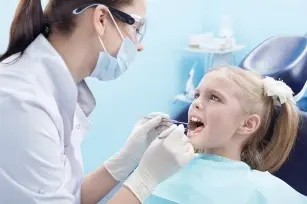Contents

Tooth decay is a common and extremely severe condition. If left untreated, it carries a number of unpleasant consequences, including tooth loss. That is why proper oral hygiene from early childhood is very important, as well as careful observation of our children’s teeth and frequent visits to the dentist.
The specificity of caries of milk teeth
Despite all the attention devoted to the milk teeth of our offspring, it may happen that caries will attack anyway. This is because the disease can sometimes be difficult to recognize. Many parents mistakenly think that they are dealing with ordinary dental plaque, when in fact it is so-called circular or bottle caries, which initially affects the gums and is not yet black in color. In addition, caries of milk teeth is characterized by an extremely rapid pace of development, so it can do a lot of damage in the blink of an eye. In critical situations, when it is no longer possible to save a sick milk tooth, lapis treatment remains.
When the alternative is tooth extraction
If the loss is very large and there is no possibility use of conservative treatment in the form of filling, you can decide to extract the diseased tooth or lapis. In the first case, we expose the child to a lot of stress, which may cause fear of the dentist in the future. In addition, premature extraction of milk teeth often disturbs the process of eruption of permanent teeth, consequently leading to malocclusion. Lapis is used to stop caries and maintain milk teeth until they are naturally replaced with permanent teeth.
What is lapis?
Lapisetting is a dental procedure consisting in impregnating a tooth affected by caries by applying a solution of silver nitrate on it. This is to harden the softened tooth mass and stop the further progression of caries. Silver nitrate, combining with the hard tissues of the tooth, forms the so-called silver proteinate, resistant to caries. A side effect is that the tooth becomes black after lapis, which reduces the aesthetics of a child’s smile until the milk tooth falls out. However, there is no fear that healthy teeth will also turn black, because the black reaction appears only where there are cavities.
How is the lapis procedure performed?
The treatment requires preparatory activities, consisting in removing plaque with a brush soaked in hydrogen peroxide. Then the teeth are rinsed with water, dried with compressed air and protected from saliva. Later, the dentist performs disinfection and applies it to the affected surfaces whip srebra. The latter activity takes an average of 2-3 minutes. Finally, the mouth remains flushed with liquidwhich knocks down whip srebra. The whole process must be repeated three times. This is usually done over a 3-week period, with a one-week interval between each treatment. It happens, however, that the doctor decides to arrange everything during one visit, performing lapis 3 times on the same day.









